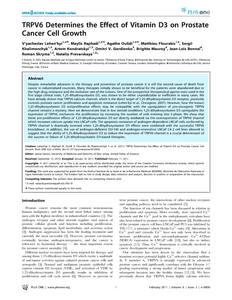Lehen'kyi, V;
Raphaël, M;
Oulidi, A;
Flourakis, M;
Khalimonchyk, S;
Kondratskyi, A;
Gordienko, DV;
Mauroy, B;
Bonnal, JL;
Skryma, R;
et al.
Lehen'kyi, V; Raphaël, M; Oulidi, A; Flourakis, M; Khalimonchyk, S; Kondratskyi, A; Gordienko, DV; Mauroy, B; Bonnal, JL; Skryma, R; Prevarskaya, N
(2011)
TRPV6 Determines the Effect of Vitamin D3 on Prostate Cancer Cell Growth.
PLOS ONE, 6 (2).
e16856.
ISSN 1932-6203
https://doi.org/10.1371/journal.pone.0016856
SGUL Authors: Gordienko, Dmytro Valerjevich
![[img]](https://openaccess.sgul.ac.uk/1447/1.hassmallThumbnailVersion/pone.0016856.pdf)  Preview |
|
["document_typename_application/pdf; charset=binary" not defined]
Published Version
Download (494kB)
| Preview
|
Abstract
Despite remarkable advances in the therapy and prevention of prostate cancer it is still the second cause of death from cancer in industrialized countries. Many therapies initially shown to be beneficial for the patients were abandoned due to the high drug resistance and the evolution rate of the tumors. One of the prospective therapeutical agents even used in the first stage clinical trials, 1,25-dihydroxyvitamin D3, was shown to be either unpredictable or inefficient in many cases. We have already shown that TRPV6 calcium channel, which is the direct target of 1,25-dihydroxyvitamin D3 receptor, positively controls prostate cancer proliferation and apoptosis resistance (Lehen'kyi et al., Oncogene, 2007). However, how the known 1,25-dihydroxyvitamin D3 antiproliferative effects may be compatible with the upregulation of pro-oncogenic TRPV6 channel remains a mystery. Here we demonstrate that in low steroid conditions 1,25-dihydroxyvitamin D3 upregulates the expression of TRPV6, enhances the proliferation by increasing the number of cells entering into S-phase. We show that these pro-proliferative effects of 1,25-dihydroxyvitamin D3 are directly mediated via the overexpression of TRPV6 channel which increases calcium uptake into LNCaP cells. The apoptosis resistance of androgen-dependent LNCaP cells conferred by TRPV6 channel is drastically inversed when 1,25-dihydroxyvitamin D3 effects were combined with the successful TRPV6 knockdown. In addition, the use of androgen-deficient DU-145 and androgen-insensitive LNCaP C4-2 cell lines allowed to suggest that the ability of 1,25-dihydroxyvitamin D3 to induce the expression of TRPV6 channel is a crucial determinant of the success or failure of 1,25-dihydroxyvitamin D3-based therapies.
| Item Type: |
Article
|
| Additional Information: |
PubMed ID: 21347289. ©2011 Lehen’kyi et al. This is an open-access article distributed under the terms of the Creative Commons Attribution License, which permits unrestricted use, distribution, and reproduction in any medium, provided the original author and source are credited. |
| Keywords: |
Biological Transport, Calcitriol, Calcium, Cell Line, Tumor, Cell Proliferation, Humans, Male, Prostatic Neoplasms, TRPV Cation Channels, Up-Regulation, Science & Technology, Multidisciplinary Sciences, Science & Technology - Other Topics, 1 ALPHA,25-DIHYDROXYVITAMIN D-3, OPERATED CA2+ CHANNELS, 1,25-DIHYDROXYVITAMIN D-3, ANDROGEN RECEPTOR, LNCAP CELLS, SIGNALING PATHWAY, EPITHELIAL-CELLS, MESSENGER-RNA, MUSCLE-CELLS, PROLIFERATION |
| Journal or Publication Title: |
PLOS ONE |
| ISSN: |
1932-6203 |
| Related URLs: |
|
| Web of Science ID: |
WOS:000287364500010 |
| Dates: |
| Date |
Event |
| 2011-02-11 |
Published |
|
  |
Download EPMC Full text (PDF)
|
 |
Download EPMC Full text (HTML)
|
| URI: |
https://openaccess.sgul.ac.uk/id/eprint/1447 |
| Publisher's version: |
https://doi.org/10.1371/journal.pone.0016856 |
Statistics
Item downloaded times since 01 May 2012.
Actions (login required)
 |
Edit Item |



